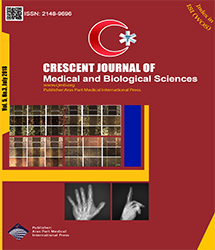| Original Article | |
| The Relationship Between Scapular Dyskinesis and Generalized Joint Hypermobility in Young Women | |
| Afsun Nodehi Moghadam1, Maryam Moghadam Salimi2, Enayatolah Bakhshi3 | |
| 1Department of Physiotherapy, Rofeideh Rehabilitation Hospital, University of Social Welfare and Rehabilitation Sciences, Tehran, Iran 2Department of Physiotherapy, Tabriz University of Medical Sciences, Tabriz, Iran. 3Department of Statistics, University of Social Welfare and Rehabilitation Sciences, Tehran, Iran |
|
|
CJMB 2018; 5: 189–193 Viewed : 4728 times Downloaded : 7141 times. Keywords : Joint hypermobility, Joint laxity, Scapula, Shoulder injuries |
|
| Full Text(PDF) | Related Articles | |
| Abstract | |
Objectives: Individuals with generalized joint hypermobility (GJH) have motions beyond the normal range in the shoulder, and less shoulder stability. Scapular dyskinesis is likely to be a consequence of weakness in scapular stabilizer muscle. This study intended to identify the relationship between GJH and scapular dyskinesis in young women. Materials and Methods: One hundred women (47 hypermobile and 53 non-hypermobile) participated in this case control study. The Beighton score was used to diagnose GJH. Visual scapular dyskinesis test (proposed by Uhl et al) was used for the evaluation of scapular dyskinesis. Scapular winging and/or dysrhythmia is observed during a set of bilateral, active, shoulder flexion, abduction and scaption (40° anterior to the frontal plane) for 5 times while having the thumbs pointed up. These movements were performed, bearing the weight on their hands. Generalized estimating equations were used in order to compare the scapular dyskinesis prevalence during shoulder flexion, abduction and scaption between the females Results: The prevalence of scapular dyskinesis in the females with GJH was twice more than that in the females with no hypermobility [OR=2.18(95% CI: 1.18-4.03)]. It was also found that there were not any signifcant differences in the prevalence of scapular dyskinesis between shoulder elevation planes (flexion, abduction and scaption) in the females with Conclusions: Higher prevalence of scapular dyskinesis in the females with GJH may place them at the risk of future shoulder pain and pathology, which should be considered in the evaluation and management of hypermobile individuals. |
Cite By, Google Scholar
PubMed
Online Submission System
 CJMB ENDNOTE ® Style
CJMB ENDNOTE ® Style
 Tutorials
Tutorials
 Publication Charge
Medical and Biological Research Center
About Journal
Publication Charge
Medical and Biological Research Center
About Journal
Aras Part Medical International Press Editor-in-Chief
Arash Khaki
Deputy Editor
Zafer Akan


















